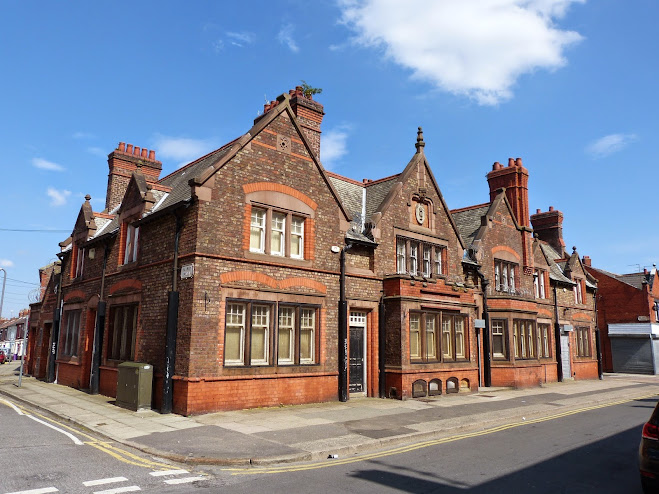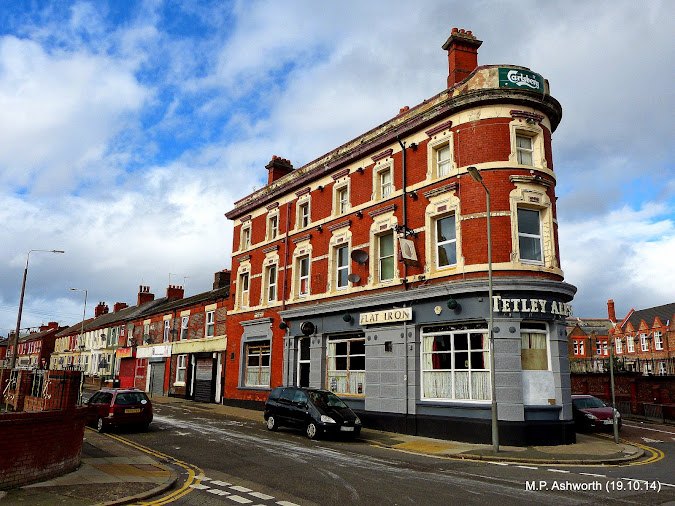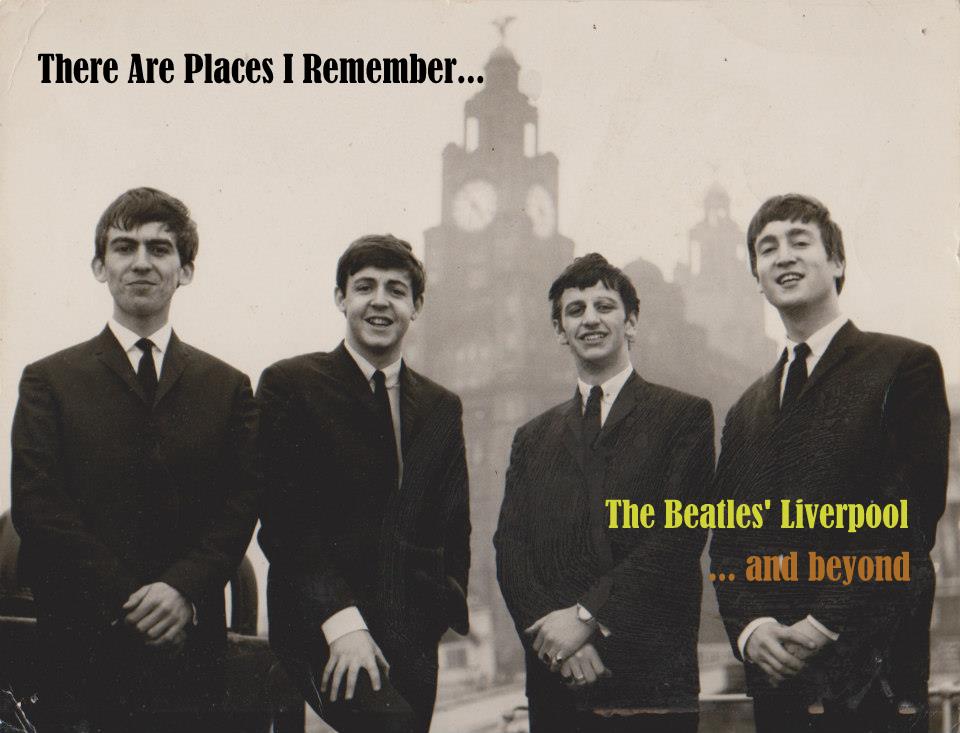The McCartneys in Anfield (1942)
Sunbury
Road,
 |
| 10 Sunbury Road, Anfield |
In late
June 1942 Jim and Mary McCartney brought their first son James Paul home to
rented rooms in 10 Sunbury Road, a large terraced house in Anfield, near to the
stadium of Liverpool Football Club.
With
all work in the Cotton Exchange suspended for the duration of the war, Jim
found work in the machine shops of D. Napier and Son, an engineering firm
situated in a new plant near the Walton end of the East Lancashire Road,
manufacturing the Sabre Piston engine for British fighter planes.
Napier
was required to expand its engine production facilities as part of the war
effort. Their factory in Acton Vale to the west of London was considered to be
a vulnerable site and by the end of October 1939, a decision had been made to
build a shadow factory in Liverpool.
 |
| The Napier Factory in Liverpool with Sabre components bottom left |
Building work
had started on the installation during 1940. With new machine shops, assembly
areas and test facilities covering a floor area of over 1 million square feet,
the factory was ready for production by the end of 1941 employing a workforce
freshly trained in precision-engineering, which had grown to in excess of
10,000 by 1942.
 |
| Some of Jim McCartney's colleagues at work in the Napier Factory. The workforce was predominantly female |
Following
a period of training Jim became an automatic setter lathe-turner on a
production line plagued with difficulties. The Sabre engine was so
technologically advanced it proved to be difficult to adapt to assembly line
production. Although the first fully tested Napier Sabre II engine to emerge
from the Liverpool Works was delivered in February 1942 subsequent
manufacturing and development problems (and the Company takeover in 1942 by the
English Electric Co.) meant that it took until 1944 for the engine to be
considered reliable enough to be used to power Hawker Typhoons and Tempests.
Keen to
do his part for the war effort, Jim had joined the Fazakerley Fire Unit whilst
still living in Norris Green and every evening after finishing at Napiers he returned
there, resuming his fire-watching and reporting when and approximately where he
saw bombs dropping. If they had fallen fairly locally he would make his way to
the site to assist in rescues and act as a fireman when called upon. When he
finally got home to Sunbury Road and climbed into bed he must have been
exhausted.
Mary
may have given up nursing for a while to look after baby Paul, and there may
have been a war on, but she was just as particular about cleanliness at home as
she had been on the ward. The story goes that one day she left Paul outside in
his pram in the yard for a bit of fresh air and when she returned was mortified
to find smudges of soot on his face. That was enough for Mary to decide that
the house in Sunbury Road was unsuitable and she told Jim that they would have
to move.
Mike
McCartney believes that their next move, to Wallasey on the other side of the
River Mersey came about through his Dad's work at Napiers. He was considered
Air Force because of his job and with it came the house. Beatles historian Mark
Lewisohn writes that the house came via a colleague of Jim's from the Cotton
Exchange.
The
publication of part one of Mark Lewisohn's definitive Beatles biography
"Tune In" has brought to my attention a number of hitherto unknown
Liverpool locations with a Beatles connection. If you're visiting Sunbury Road
it's worth making a short journey down Anfield Road past the fine old Police
Station and school buildings on your left to the junction with Walton Breck
Road.
 |
| The Police Station on Anfield Road (then) |
 |
| The Police Station on Anfield Road (now) |
 |
| Anfield Road School |
The Lennons in Anfield (1890s)
 |
| Flat Iron Pub with Walton Breck Road (left) and Anfield Road School on the right |
Half a
century before the McCartneys moved to Anfield, John Lennon's great grandfather
James Lennon and his family were living at 373 Walton Breck Road.
James
and his wife Jane, both from Irish Catholic families who had fled County Down
and travelled to Liverpool to escape the Great Famine around 1845, had lived in
numerous houses in the 40 odd years since their arrival.
James
had worked variously as a warehouse man and labourer but by 1891, at the age of
60, he was running his own family business, James Lennon and Co. Car
Proprietors from no. 373. Also living in the house was his seventh and youngest
son Edward (age 25, occupation: car driver), Edward’s wife Ann Jane (nee Rigby)
and their 'nephews' Richard Henry (age 5) and Edward (age 3) who were actually their two sons.
The
Lennons owned horsecars – originally assumed to be horse drawn trams, which were prevalent in Liverpool
until the 1897 introduction of electric models - but more recently thought to be a carriage (coach) drawn by a horse.
 |
Horsecar No 330, probably photographed in 1903. This car formed the last horse-drawn service to run in Liverpool on 25th August 1903. (Photo courtesy of David Voice and the Tramways and Light Railway Society) |
 |
| The Lennon's house, no. 373 is the white door to the left of the black shutters above |
Today
No. 373 not only remains but does so substantially unaltered since the Lennon's
time, retaining the integral garage space from where James and Edward operated
their horsecar service.
On the
horizon in the above photo you can just make out the Anfield stadium of
Liverpool Football Club which was founded in 1892, right at the time the
Lennon's horsecar business was in operation. The club was created following a
dispute between the Everton football club committee and Jack Houlding, club
president and owner of the land at Anfield where Everton had played for eight
years. Everton relocated to Goodison
Park in 1892 and Houlding founded Liverpool Football club to play at Anfield.
 |
| The garage entrance at the back of no. 373 Walton Breck Road, as viewed from Anfield Road (marked with arrow). |
 |
| The Flat Iron, 2014 |
Adjacent
to no. 373 Walton Breck Road is the Flat Iron Public House and according to Mark Lewisohn's Tune In, there are tales
here concerning another of John Lennon's relatives, his paternal grandfather,
John "Jack" Lennon, the son of James Lennon.
After
the death of his second wife, Margaret Cowley in 1892, Jack Lennon raised his daughter Mary with the assistance of his housekeeper, Mary
"Polly" Maguire. It was around 1894 when Jack and Polly started living
as man and wife. Polly soon found herself pregnant, more often than not. They
had 15 children; tragically 8 died young.
.jpg) |
| John "Jack" and Polly Lennon, John Lennon's paternal grandparents |
Jack
would have been in the area because his father was running his business from
their garage-cum-home two doors down from the pub but unlike his brother Edward
he does not appear to have lived there for any length of time, if at all.
However, in 1894 the Lennons were regular patrons in the Flat Iron and there
are stories of Jack Lennon, gambler and drinker singing loud and often around
the ale-houses.
One
tale has Polly, wrapped in the shawl typical of Liverpool Irish women, hair
wound tightly in a bun, 'short, solid and muscly with the bravery and bravado of
many of her kind' entering the pub one boozy Christmas Eve to find Jack standing
on a table. "Here entereth the woman now!" he bellowed to which she
roared "Get home with your bloody wages now!"
 |
| Polly Lennon in later life |
Between
1894 and 1897 John (Jack) and Polly had a number of addresses including three
places in West Derby - No. 34 Tudor Street,
No.33 Bourne Street, No. 115 Butler Street and one at 12 Caradoc Road in
Seaforth, the house where they were living in 1898 when Jack's father James
Lennon passed away.
James
Lennon died at the age of 68, and perhaps the business died with him as by 1901
his youngest son Edward was living at 14 Job Street in West Derby, Edward’s
occupation perhaps now enhanced to the position of “Coachman Groom”. The last
horse drawn tram ran on 25 August 1903 so he would have had to have found alternative employment in his later years.
Jack
and Polly had moved to the Toxteth area of Liverpool around 1899. Two years
later the 1901 census found them at 3 Lockhart Street, Toxteth Park. John
(Jack) Lennon (46) Shipping Clerk born Liverpool, is living with Mary (Polly)
Lennon (28) wife born Liverpool and his daughter Mary Elizabeth Lennon (12)
born Liverpool. At some point they also lived at number 20 Lockhart Street.
These Toxteth streets were all in the proximity of Mill Street, on the end of which was a pub called the Flat Iron, and for this reason I think the tales of Jack Lennon's drinking belong here rather than in Anfield.
On 14
August 1905 their son George Lennon was born at 25 Denton Street, Toxteth Park.
John (Jack's) occupation was given as Freight Clerk. The child's mother was Mary Lennon formerly
McGuire, except that in reality, she wasn't. Jack and Polly were not yet
married.
Further
children followed including Herbert Lennon born 18 April 1908 and Sydney Lennon
born on 26 September 1909 at 27
Copperfield Street, one of the "Dickens" streets inToxteth Park.
On 14
December 1912, Alfred Lennon, the future father of Beatle John Winston Lennon, was
born at 27 Copperfield Street, Toxteth Park.
Three
years later on 27 January 1915 John (Jack) Lennon (then aged 59) finally
married Mary (Polly) Maguire (42) at West Derby Register Office, Liverpool. He was a widower and their address was given
as 27 Elmore Street, Everton. He was by then a "Dock Labourer" and
their respective fathers were James Lennon (deceased), a Car Proprietor, and
James Maguire, a retired Horse Keeper.

 |
| Map of the general area showing Walton Breck Road, Anfield Road and Sunbury Road |
A map
of the area showing clockwise from top left Anfield Stadium, Sunbury Road, the
Police Station and School on Anfield Road, and the Flat Iron Pub (marked P.H on
the junction of Anfield Road and Walton Breck Road). No. 373 is marked with an
X to the immediate left of the P.H. (Click to enlarge)
John
"Jack" Lennon died on 3 August 1921 at 57 Copperfield Street, Toxteth
and was subsequently buried in Anfield Cemetery, not far from Walton Breck
Road. Polly died on 30 January 1949 also
at Copperfield Street where she would meet her grandson John Lennon at least
once in 1944 before she passed.
The Epsteins in Anfield (1900-1946)

One
final place of interest to Beatles fans visiting this area can be found at No.
27 Anfield Road, the family home of Brian Epstein, the Beatles' manager.
Brian's
grandfather, Isaac Epstein, (born 1877) was a Jew from Lithuania (then part of
the Russian Empire), who arrived in Britain in the 1890s, around the age of
eighteen or nineteen and speaking only Yiddish. In 1900 in Manchester, he
married Dinah, the daughter of Joseph (a draper), and Esther Hyman, who had
emigrated from Poland to Britain (circa 1871-72), with their eldest son, Jacob.
In
1901, Isaac and Dinah were living at 80 Walton Road, Liverpool, with Isaac's
sister, Rachael Epstein, above the furniture dealership he had recently opened.
Dinah
and Isaac's third child was Harry Epstein, Brian Epstein's father, born in
1904. After Harry and his brother Leslie had joined the family firm, Isaac
Epstein founded "I. Epstein and Sons". Their successful family business expanded
further when they bought the neighbouring shop - the North End Music
Store (known as NEMS) in 1929, where Jim McCartney's family had once bought a piano.
In 1927
the Epsteins moved to this larger home at 27 Anfield Road, Liverpool. They were
still there when Jim, Mary and baby Paul McCartney moved in to Sunbury Road for
a period in 1942, and would remain there until 1946. It was converted into a
Beatles-themed hotel called Epstein House in 2003.
Source:
Thank U
Very Much (Mike McCartney 1982)
Tune In
(Mark Lewisohn 2013)
The
Epstein House hotel featured in series 10 of Channel 5's "The Hotel
Inspector" in February 2014:
Follow me:
Facebook: There Are Places I Remember
Instagram: Beatles Liverpool Locations
Twitter: There Are Places I Remember








Thanks for the memories. My great-aunt lived at number 9 Sunbury Road I stayed there often.
ReplyDelete